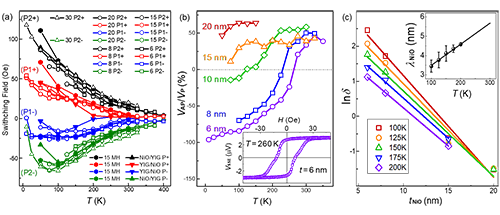Magnon valve effect based on YIG/NiO/YIG insulating magnon junction
Date:14-01-2019 Print
After the 1st generation of semiconductor-based microelectronics and the 2nd generation of spintronics, magnonic devices based on magnons are widely believed to be a potential candidate for the next generation of platform for the development of information technology in the future.
Data processing and transmission in sophisticated microelectronics rely strongly on electric current, which inevitably wastes a large amount of energy due to Joule heating. However, Magnons which possess angular momenta and can also transfer the momenta, can be regarded as a new information carrier free from Joule heating due to electric neutrality. Moreover, the wave nature of magnons provides additional merits: (1) long propagation distance up to millimeters and (2) an available new degree of freedom (magnon phase). These are of extreme benefit for the realization of non-Boolean logic devices. Besides, based on the interconversion effect of magnonic moments and electron spins, classic spintronic and emerging magnonic circuitry can be integrated and interoperated with each another in a single device. Furthermore, the quantum effect of magnon can cause some other macroscopic quantum phenomena, such as spin superfluid and magnon Josephson effect. These characteristics make magnons ideal information carriers based on which some electronic components for future magnonic circuits can be developed.
In Institute of Physics, Chinese Academy of Sciences (IOPCAS), M02 group headed by Prof. Xiufeng Han have developed magnon valves and insulating magnon junctions that can be used for regulating magnon transport. They experimentally investigate magnon transport in the magnon valve structure FMI/NM/FMI (YIG/Au/YIG). It is noted that the device was made by magnetron sputtering technique which is very suitable for mass-production. Magnon current can be modulated high and low by the parallel and antiparallel magnetic configurations of the magnetic YIG layers. In this case, angular moments are transferred between YIG and Au layers via interconversion of unique magnon current and regular spin current [Hao Wu and X. F. Han et al., Phys. Rev. Lett. 120 (2018) 097205, DOI: https://doi.org/10.1103/PhysRevLett.120.097205, Editors’ suggestion & Featured in Physics].
In order to construct a pure magnon valve, Prof. Xiufeng Han and his colleagues further design and experimentally realize a typical MI/antiferromagnetic insulator (AFI)/ MI heterostructure using YIG/NiO/YIG sandwiches. Such a MI/AFI/MI heterostructure is named as an insulating magnon junction (IMJ). Fully electric-insulating and merely magnon-conductive magnon valves have been demonstrated by the YIG/NiO/YIG IMJs in which output spin current in a Pt detector can be tuned with a high on-off ratio between parallel (P) and antiparallel (AP) states of the two YIG layers near room temperature. When temperature gradient is applied through an IMJ, magnon current would flow from one MI to the other MI through the AFI spacer. So, the net magnon current in the second MI are easily influenced by the first MI layer. Then setting a heavy metal Pt on the top MI layer, one could detect the magnon current via inverse spin Hall effect, similar to the TMR effect observed in a magnetic tunnel junction. Furthermore, the magnon valve ratio (MVR) or on-off ratio of the so-called IMJ can be as high as 100%. Hence, this typical IMJ device are likely to play a core role in the future magnon device of integrated magnon circuits for information transmission, logic computing and magnetic field sensing. This work has been published in Physics Review B [C. Y. Guo, C. H. Wan & X. F. Han et al., Phys. Rev. B. 98 (2018) 134426]. This work was supported by the National Key Research and Development Program of China (MOST) and the National Natural Science Foundation of China (NSFC).
Links: https://journals.aps.org/prb/abstract/10.1103/PhysRevB.98.134426
 |
| Fig. 1. Microstructure of the GGG//YIG(100)/NiO(15)/YIG(60) IMJ. (a) The cross-sectional TEM image of the sample. HRTEM images of (b) the GGG//YIG(100) and (c) YIG(100)/NiO(15)/YIG(60) interfaces, respectively. Fourier transformation of HRTEM for (d) the bottom YIG and (e) the top YIG only. (f) Schematic diagram of spin Seebeck effect and its measurement setup for an IMJ. During measurement, a field in the x-axis is applied. |
 |
| Fig. 2. (a) The dependence of switching fields of all the IMJs and the control samples on temperatures. (b)VAP/VPratios for the IMJs. Inset shows the field dependence ofVSSEfor the IMJ with 6 nm NiO spacer and ultrahigh on-off ratio at 260 K. (c) Thickness dependence of lnδ at medium temperatures. Insets show derived magnon decay lengthλNiO. |


